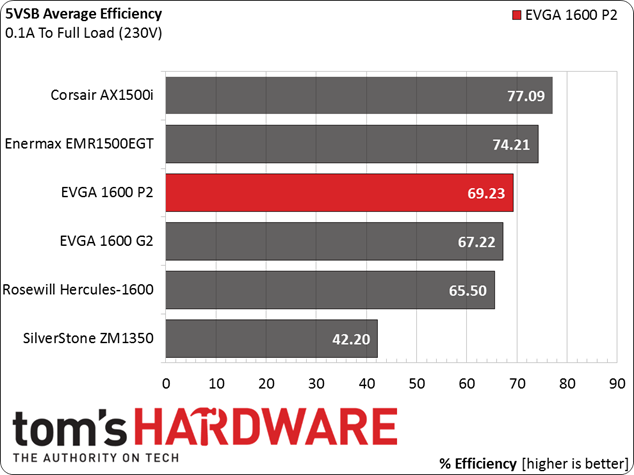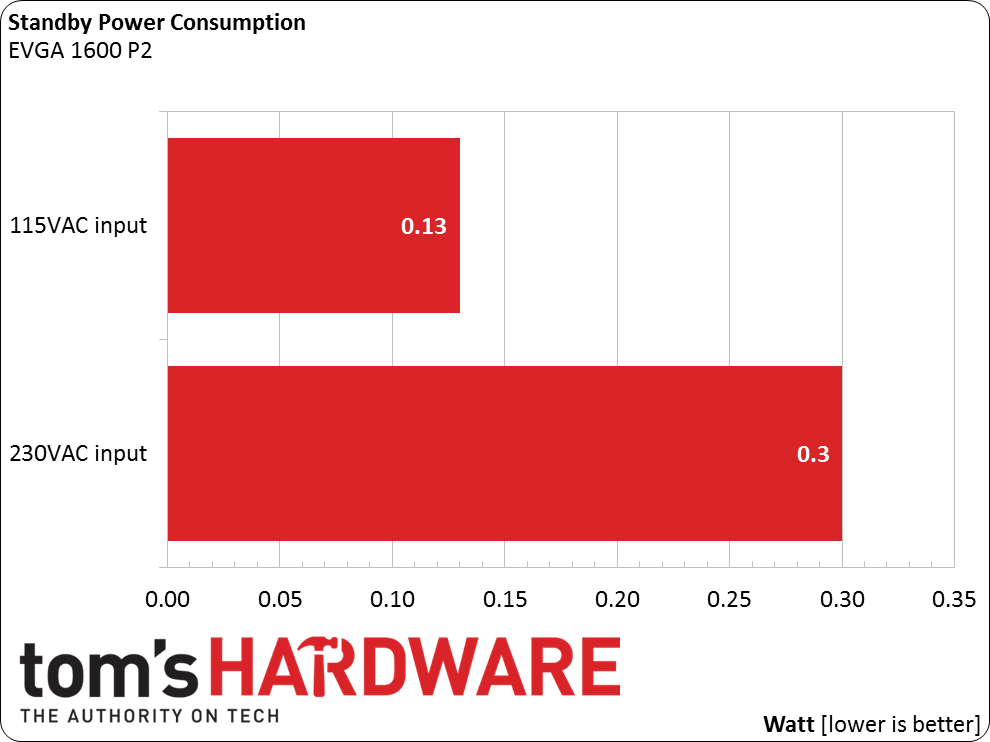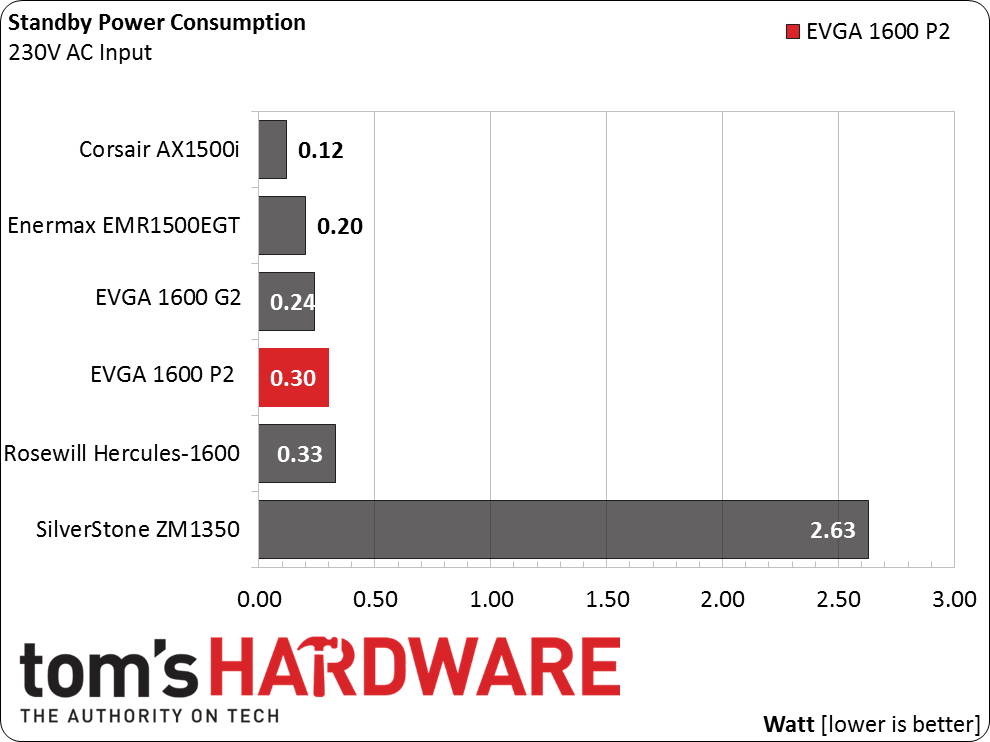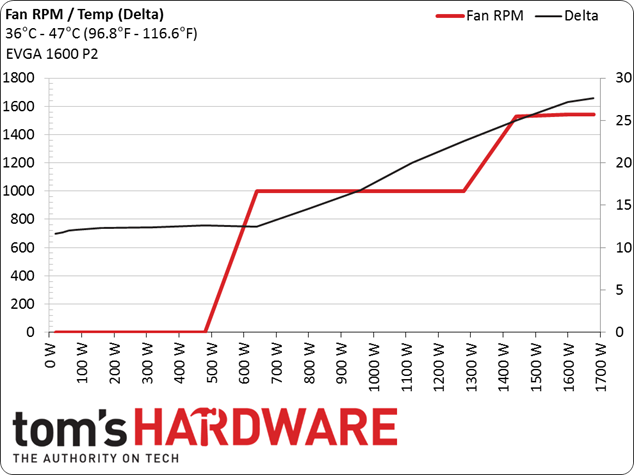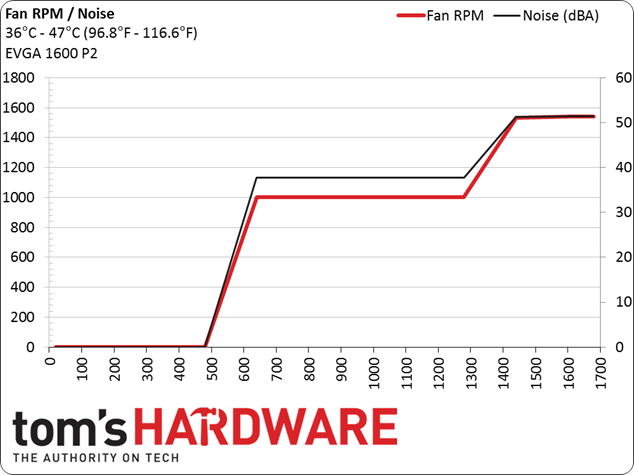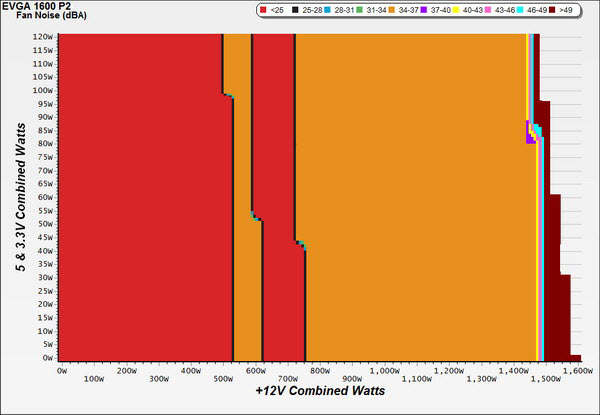EVGA SuperNOVA 1600 P2 Power Supply Review
EVGA recently introduced its flagship power supply, the SuperNOVA 1600 P2. In addition to monstrous capacity, it also features 80 PLUS Platinum efficiency, promises top performance levels and offers silent operation in semi-passive mode.
Why you can trust Tom's Hardware
Efficiency, Temperatures And Noise
Efficiency
Using the results from the previous page, we plotted a chart showing the efficiency of the 1600 P2 at low loads and at loads equal to 10 percent to 105 percent of the PSU's maximum capacity.
The 1600 P2 is a highly efficient PSU even under light loads, which definitely aren't the favorite playground for such high-capacity units. With 115V input, the unit registers a higher average score in the low-load range (20-80W). However, with higher loads the situation turns in favor of 230V. Also, at both light and normal loads, the 1600 P2 easily takes the lead from its Gold-rated sibling (1600 G2). It loses only to the Titanium-rated Corsair AX1500i in 20 to 100 percent of its max-rated capacity load. If we take into account that the AX1500i is an almost fully digitally-controlled unit while the Super Flower platform is based on analog circuits, this is quite a feat. Who said that analog circuits don't have anything left to offer?
Efficiency at Low Loads
In the next tests, we measure the efficiency of the 1600 P2 at loads significantly lower than 10 percent of the device's maximum (the lowest load the 80 PLUS standard measures). The loads we dialed were 20, 40, 60 and 80W. This is important for representing when a PC is idle with power-saving features turned on.
| Efficiency at Low LevelsEVGA SuperNOVA 1600 P2 | |||||||||
|---|---|---|---|---|---|---|---|---|---|
| Test # | 12V | 5V | 3.3V | 5VSB | DC/AC Watts | Efficiency | Fan Speed (RPM) | Fan Noise (dB[A]) | PF/AC Volts |
| 1 | 1.192A | 0.491A | 0.480A | 0.196A | 19.66 | 57.17% | 0 | 0 dB(A) | 0.820 |
| 12.239V | 5.059V | 3.323V | 5.057V | 34.39 | 115.1V | ||||
| 2 | 2.409A | 0.979A | 0.991A | 0.396A | 39.72 | 72.04% | 0 | 0 dB(A) | 0.899 |
| 12.236V | 5.058V | 2.323V | 5.025V | 55.14 | 115.0V | ||||
| 3 | 3.629A | 1.476A | 1.505A | 5.048A | 59.84 | 78.23% | 0 | 0 dB(A) | 0.931 |
| 12.234V | 5.057V | 3.321V | 5.048V | 76.49 | 115.0V | ||||
| 4 | 4.840A | 1.973A | 1.985A | 0.790A | 79.75 | 82.36% | 0 | 0 dB(A) | 0.951 |
| 12.232V | 5.055V | 3.320V | 5.042V | 96.83 | 115.0V |
At only 20W, efficiency drops below 60 percent. In the remaining two tests, it climbs above 70 percent. However, only during the last test and under an 80W load does it manage to surpass the 80-percent mark. For a 1600W beast, it does well. Best of all, during the entire light-load test session, the PSU operated in fanless mode.
5VSB Efficiency
The ATX specification states that 5VSB standby supply efficiency should be as high as possible, recommending 50 percent or higher efficiency with 100mA of load, 60 percent or higher with 250mA of load and 70 percent or higher with 1A or more of load.
We took four measurements: one each at 100, 250 and 1000mA, and one with the full load the 5VSB rail can handle.
| 5VSB EfficiencyEVGA SuperNOVA 1600 P2 | ||||
|---|---|---|---|---|
| Test# | 5VSB | DC/AC Watts | Efficiency | PF/AC Volts |
| 1 | 0.102A | 0.52 | 70.27% | 0.040 |
| 5.058V | 0.74 | 115.2V | ||
| 2 | 0.252A | 1.27 | 74.71% | 0.08 |
| 5.054V | 1.70 | 115.7V | ||
| 3 | 1.003A | 5.06 | 79.31% | 0.265 |
| 5.014V | 6.38 | 115.4V | ||
| 4 | 3.002A | 15.01 | 78.83% | 0.434 |
| 5.001V | 19.04 | 115.3V |
In our opinion, the 5VSB circuit isn't worthy of this high-end platform. It is efficient enough for a mid-level PSU, but in a Platinum-rated model, we would like to see readings above 80 percent in the last two tests. On top of that, the SuperNOVA 1600 P2 deserves a stronger 5VSB rail with at least 4A of current output.
Get Tom's Hardware's best news and in-depth reviews, straight to your inbox.
Power Consumption In Idle And Standby
| Idle / StandbyEVGA SuperNOVA 1600 P2 | ||||||
|---|---|---|---|---|---|---|
| Mode | 12V | 5V | 3.3V | 5VSB | Watts | PF/AC Volts |
| Idle | 12.243V | 5.060V | 3.325V | 5.062V | 12.92 | 0.524 |
| 115.3V | ||||||
| Standby | Row 3 - Cell 1 | Row 3 - Cell 2 | Row 3 - Cell 3 | Row 3 - Cell 4 | 0.13 | 0.007 |
| 115.4V |
In the table above, you find the power consumption and voltage values of all rails (except -12V) when the PSU is in idle mode (powered on, but without any load on its rails), and the power consumption when the PSU is in standby mode (without any load at 5VSB).
Phantom power is low using 115V and a little higher with 230V input. However, in both cases, the 1600 P2 easily meets the ErP Lot 6 2013 requirements.
Fan RPM, Delta Temperature And Output Noise
The following chart illustrates the cooling fan's speed (RPMs) and the delta between input and output temperature. The results were obtained at 38 to 45 degrees C ambient temperature.
This next chart shows the cooling fan's speed (RPMs) and output noise. We measured acoustics from one meter away, inside a small, custom-made anechoic chamber with internals completely covered in soundproofing material (be quiet! Noise Absorber kit). Background noise inside the anechoic chamber was below 20 dB(A) during testing, and the results were obtained with the PSU operating at 38 to 45 degrees C ambient temperature.
The following graph illustrates the fan's output noise over the entire operating range of the PSU. The same conditions of the above graph apply to our measurements, though the ambient temperature was between 28 and 30 degrees C.
As you can see from the graph above, at normal operating conditions the PSU "runs" in passive mode for a pretty long period. At around 550W, the fan engages at low speed. After it exhausts most of the waste heat it switches to passive mode again. Afterward, the fan spins at low RPM up to about 1500 W. And when things get really tough, it switches to a higher speed—around 1500 RPM, according to our tests. This unit manages to combine two attributes that usually don't get along: high power and quiet operation.
Current page: Efficiency, Temperatures And Noise
Prev Page Load Regulation, Hold-Up Time And Inrush Current Next Page Cross-Load Tests And Infrared Images
Aris Mpitziopoulos is a contributing editor at Tom's Hardware, covering PSUs.
-
damric Good review, but missing the hot box testing to see if this thing regulates and suppresses ripple at 50C as advertised.Reply -
Aris_Mp All tests were conducted at high ambient temperatures which during full load were above 47C. Only the Cross-Load tests were conducted at 28-30C.Reply -
Giannis Karagiannis Very detailed review indeed. There isn't really anything that could be covered and it is not. I don't think that there are many PSU manufacturers out there that can test their products so extensively.Reply -
Aris_Mp I had the opportunity to test the 2 kW model (from Super Flower) and it is indeed superb. But it will provide 2 kW only with 230 VAC input since a normal socket can deliver only up to 15 A of current.Reply -
damric Reply15234131 said:Too light for me I have the 2000w coming from Dabs when it comes to retail.
Where are you from that you need all that power? Cybertron? -
damric Reply15233469 said:All tests were conducted at high ambient temperatures which during full load were above 47C. Only the Cross-Load tests were conducted at 28-30C.
47C ambients? Must have been sweating your language, please off, or you are language, please me. -
damric Reply15234630 said:I'm going to power my Skynet build with it.
One day you need to show us a picture of everything. I've seen little snapshots here and there, but I'd like to see it all in one thread.

